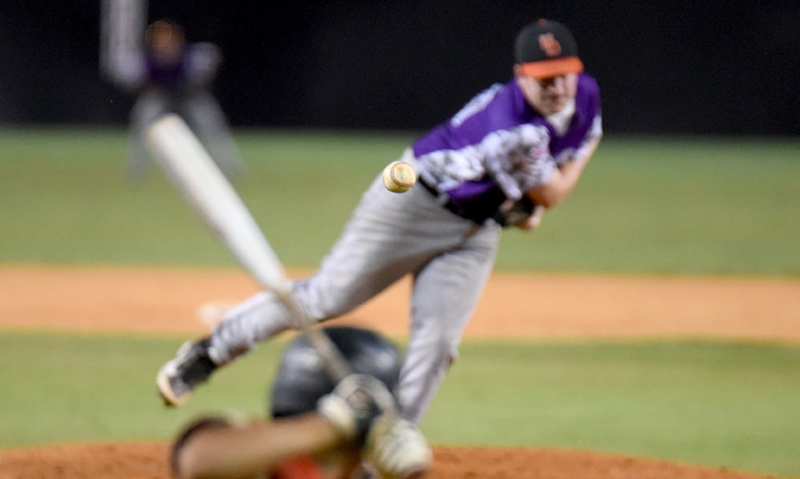
FAQ: Legion Baseball’s pitch count rule
Note: On March 23, 2017 Legion Baseball adjusted the pitch count rule as noted here.
American Legion Baseball announced last week the addition of a pitch count rule ahead of the 2017 season.
The new rule puts a daily limit on pitchers of 120 pitches in the senior program and 105 pitches in the junior program. A pitcher may finish pitching to a batter should the limit be reached in the middle of a plate appearance.
In addition, based on the number of pitches thrown, there is a rest requirement of one day (1-45 pitches thrown), two days (46-60 pitches), three days (61-75 pitches) or four days (76+ pitches).
Pitchers may not make more than two appearances in any three-day span.
In order to ease the transition, Legion Baseball Committee Chairman Gary Stone answered some frequently asked questions regarding the change.
Q: What caused the change to pitch counts?
Stone: Years of research and discussion led to this point. Major League Baseball and USA Baseball have partnered with some of the best minds in the business and have done some fantastic studies to help minimize arm overuse injuries in pitchers. They have come to two undeniable conclusions: overuse causes arm injuries and pitch counts are the best way to track pitcher usage.
Q: Who was involved in this decision?
Stone: This rule was crafted through a discussion of all department baseball chairmen and the baseball committee. Taking feedback from coaches and research from numerous sources, the rule was designed with the primary focus of safety. Every reputable organization in the country has pitch counts, or is working toward Pitch Smart compliance, so we looked to see what others were doing well and where the struggles were. We want to make tracking as easy as possible, make punishment as clear as possible, and to close any potential loopholes that would arise.
Q: Pitch Smart’s recommendations say that pitchers throwing 1-30 pitches can pitch the next day but Legion Baseball’s new rule says they are required to have a day off. Why is this?
Stone: This was a product of a lot of research and a pilot program. Pitchers who throw "one pitch" don’t truly throw just one pitch with the stress of the entire process of preparing to pitch. We also found that not enforcing rest after every appearance led to a lot of abuse and loopholes that harmed pitchers’ long-term health.
Q: The senior program allows 120 pitches and the junior program allows 105 pitches. Is that too much for younger players who are competing at a higher level?
Stone: For our senior program, which is for players 19 years old and younger, we chose to go with the limits for 19-year-olds. The same goes for our junior program (under 17) following guidelines for 17-year-olds. The rule book will have language suggesting that coaches limit players to their age-specific guidelines (e.g., a 16-year-old pitcher on a senior team should be limited to 95 max pitches, although 120 pitches is allowed). Ttrying to have three different rules within a level would put a tremendous burden on our coaches and would make enforcement nearly impossible.
Q: Has Legion Baseball considered expanding rosters or shortening games to accommodate these changes?
Stone: Everything is on the table in order to make our program better and safer. At this time, neither of those changes will be in effect for 2017, but we will certainly accept feedback to perfect the rule in the future. Feedback is, and has been, very split on switching to seven-inning games. The majority of our rosters are under 18 players and expansion would cause increases in insurance costs that would burden many teams across the country. At this time, neither option seem appropriate, but we always welcome feedback from our department baseball chairmen.
Q: How can this be enforced? Who is in charge?
Stone: Many programs across the country have successfully implemented pitch counts and we expect Legion Baseball to be the same. Coaches from each team will keep track of pitch counts, as most do already, and the umpire-in-chief will be the arbitrator should issues arise. Once we get to the national tournament, official scorers are available to help with the process, as well. There is certainly a level of trust that is required of coaches, but Legion Baseball has the best group of coaches in the country, in my opinion, and the overwhelming majority will do what is right for the safety of our players.
Q: What else can be done to help minimize arm overuse injuries?
Stone: Pitch Smart is a great resource for pitchers, coaches and parents. Our rule book will have a full list of recommendations. Two of the most important suggestions are to not pitch with a sore or injured arm and to make sure to actually rest between games and in the offseason.
Q: What is defined as a “day” in these mandates?
Stone: It goes by calendar days regardless of time of day in which the games take place or the number of games in a day. If a pitcher throws 60 pitches on Monday, he or she is required to take two days of rest (Tuesday and Wednesday) and is eligible to return on Thursday.
Q: Who do I contact if I have more questions?
Stone: The department baseball chairmen are the best resource for additional questions. Find a contact list at www.legion.org/baseball/contacts.
